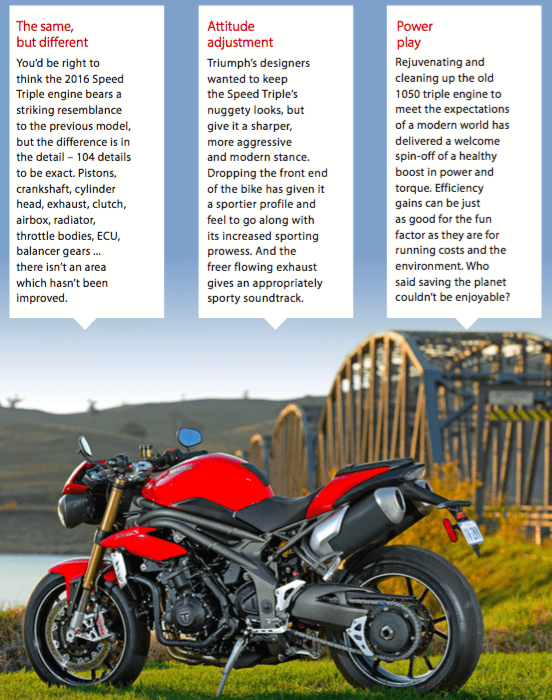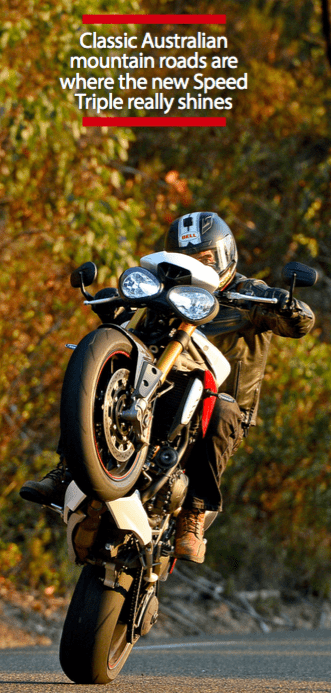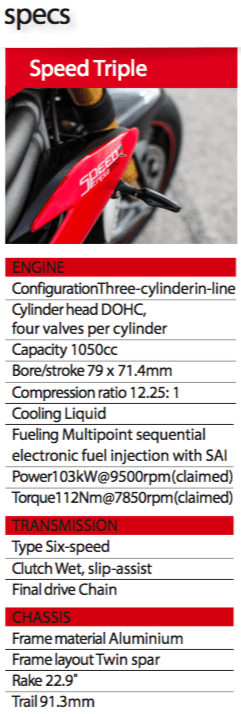Having recently been accused by one of our more imaginative and articulate readers of sharing showers with Triumph owner John Bloor, I have no desire to stoke that particular fire of suspicion by waxing lyrical on the joys of Hinckley’s finest exports once again. Nether the less, I have now tested the 2016 Triumph Speed Triple on Aussie roads, and this is something I cannot simply un-test. So, here we go again JB. I believe it’s your turn to drop the soap…
For those of you who have just tuned in, I once worked as a test rider with Triumph’s R&D department. So although I’ve never owned a Speed Triple, there wouldn’t be many folk who’ve done more miles on them. I’m also a huge fan, and can say I’ve played my part in the evolution of the model since 2004 until I left the UK in 2013.

My knowledge of things which confidentiality and respect prevent me from divulging extend to plans which would have made the Speed Triple, and Triumph’s flagship sportsbike, very different motorcycles from the one you see here. I’m sure that bike (or bikes; I can’t say) would have been excellent. But now that I’ve tested it, I’m also sure this evolution model will make old Speed Triple fans mad-keen to trade up, and charm new blood into the model’s band of very merry followers.
Taking the Speed Triple into the Australian high country may at first seem the equivalent to a North Sea cod holidaying in the Simpson desert – the original street brawler is regarded in its homeland as very much the quintessential urban attitude attaché, akin to a mechanical pit bull. But there is a lot to the latest Hinckley-bred 1050 naked which makes it far from a fish out of water in the Antipodean hinterland. In fact, some of the most unheralded of its myriad changes seem categorically crafted to make the new ‘Nipple’ the most well-suited yet for our often extreme riding conditions.

Owners of previous models will have become very used to hearing the radiator fan drowning out the wonderful lilting rumble of the in-line three, all on account of poor cooling efficiency. In Australia, with our very un-British temperatures, this not only affects low- speed urban riding, but pretty much any trip when the weather is warmer than a Pommy pint.
The revised engine design improved this area of performance markedly, and it has been achieved with a smaller radiator than the previous hot- running model. Wonderful things can happen when design engineers are forced to focus on efficiency to pass new emissions laws and prolong an engine’s production life. Stuff gets fixed, finally.
Ride-by-wire throttle is the key instrument by which the Triumph range is methodically being revolutionised, and the Speed Triple is no exception. This also has much to do with the revised 1050 engine running cooler, as well as being far more fuel efficient. It’s now not possible to overload the engine unnecessarily with throttle – a habit which wastes fuel and creates heat – because your right hand is no longer deciding how much air and fuel enters the combustion chamber. The Speed Triple’s engine management unit makes all the decisions now. Rain, Road, Sport and Track riding modes, plus a Rider programmable mode, lets you adjust the ECU’s attitude and urgency, but the actual movement of the throttle butterflies are strictly off-limits to human interference. On many modern electronics-heavy bikes this can feel like an unreasonable intrusion into the rights of the rider to control the bike’s lunacy level.
On the new Speed Triple, however, all I feel is a vastly improved throttle response and smoothness of both acceleration and deceleration over the outgoing cable-operated model. It’s the same old bulldog, but with a much refined feel. Deactivating the traction control is like jumping on the pre ride- by-wire Speed Triple, but with more power and better fuelling. It’s faster, and easier to ride fast.
A frenetic switchback ascent of Mount Buffalo brought out all that is good about the 2016 Speed Triple: constant opening and closing of the throttle in rapid succession, wavering transient states of throttle as you flick the bike left-right-left threading through fast esses towards the next 180o hairpin. These are areas which benefit greatly from the stability of ride-by-wire and its ability to balance out unintended micro throttle-inputs. A better response to atmospheric changes as you climb the mountain are also a benefit of more sophisticated engine management, but the only sign of this is that nothing actually changes.
These kinds of highly technical classic Australian mountain roads are where the new Speed Triple really shines.

This particular road with its multiple gear changes up and down the gearbox also highlighted another attribute of the heavily updated bike. The 1050 triple engine once housed the worst gearbox in the Triumph range – a six speed ’box with zero feel and five neutrals. A total shocker. After many years of tireless and essential work, Triumph has made not only the 1050’s gear selection as slick and positive as the best in the game, it has brought the improvement to all the latest models. This has been achieved with tighter tolerance stacks, increased quality and its control, and a selector mechanism first developed on the Tiger 800 which is being adapted to other engines.
Flip-flopping up this wildly wandering strip of bitumen I discovered the Speed Triple has gained sprightlier handling while miraculously also becoming more stable under acceleration than the old model. An all-new and lighter crankshaft can take much credit for the improvement in fast direction changes, giving a nimbleness not dissimilar to the whippet-like 675cc Street Triple.
Light-footedness plays a big part in enjoying a bike on our best Aussie roads, but stability is paramount for keeping it on the black stuff. Pot- holed and heat distorted roads are a common hazard here, particularly when seeking lesser known traffic-free gems to carve up. The 2016 Speed Triple has a suspension platform which may seem unsettlingly firm at first, but makes more sense the longer you ride it. As well as providing the stability for staying true to line even after a big hit, it gives an accuracy of steering which makes the many softly suspended sports-nakeds seem wayward in comparison.
Initial impressions from some riders on this Australian launch were in favour of the S model’s Showa suspension and its slightly softer feel. But once into the mountains and proper scratching territory, opinions changed as the Öhlins units fitted to the R model illustrated the benefits of their more linear damping control. They’re not harsher, but simply tauter and more stable, and this is how the R model out-manoeuvres its S-spec sibling.
By maintaining its front-rear balance the R stays on line and responds more accurately to rider input. Although it’s only the genuinely superior suspension that gives the R model its performance advantage, its still worth forking out for.

The Brembos fitted to both models were easily up to the constant abuse of long hairpin-laced alpine descents without a hint of fade. The feel and progression at the lever is a definite improvement from the sometimes grabby anchors of old, but there is still all the bite you need when you choose to haul it up in a hurry.
Triumph’s slip-assist clutch – incidentally first developed by some shady Aussie expat on his Daytona 675 racebike – allows the use of lighter clutch springs despite the new 1050 engine gaining 5 per cent torque. This lighter lever action is great for commuting comfort, but it’s on aggressive corner entry where the performance benefits of the slipper mechanism are obvious. Gone is the old bike’s snatchy clutch release after a late down- change. Instead the rear reacts calmly to sudden back-torque. Composure is what the new Speed Triple has gained in spades, and by many means.
Thankfully, Triumph’s traction control has moved on since its earliest attempts on the Explorer 1200 – rudimentary would be putting it politely. Composure is hard to keep when a bike is jerking about like a demented Dalek, but the Speed Triple’s TC system is refined enough not to spoil the flow, should you ever want to leave it switched on. Which you probably will most of the time due to it defaulting to ‘TC on’ every time the ignition is killed. Faffing with rider modes on every start up is a drag, but is also my only real gripe with the bike. Triumph’s Speed Triple has always been a bike for riders with base needs, a thirst for excitement, and perhaps sometimes a penchant for playing the fool. Those same riders, like the Speed Triple, have matured over the past 21 years, but the base needs are still there, and the temptation for bit of harmless hijinx still calls once in a while.
That’s why I’m glad Triumph has thoroughly modernised the old model, and not replaced it. The rough edges have been knocked off to reveal what it always promised, but never quite delivered in a truly polished form: a real world sportsbike worthy of defending its badge’s honour up any mountain pass you care to point it.















